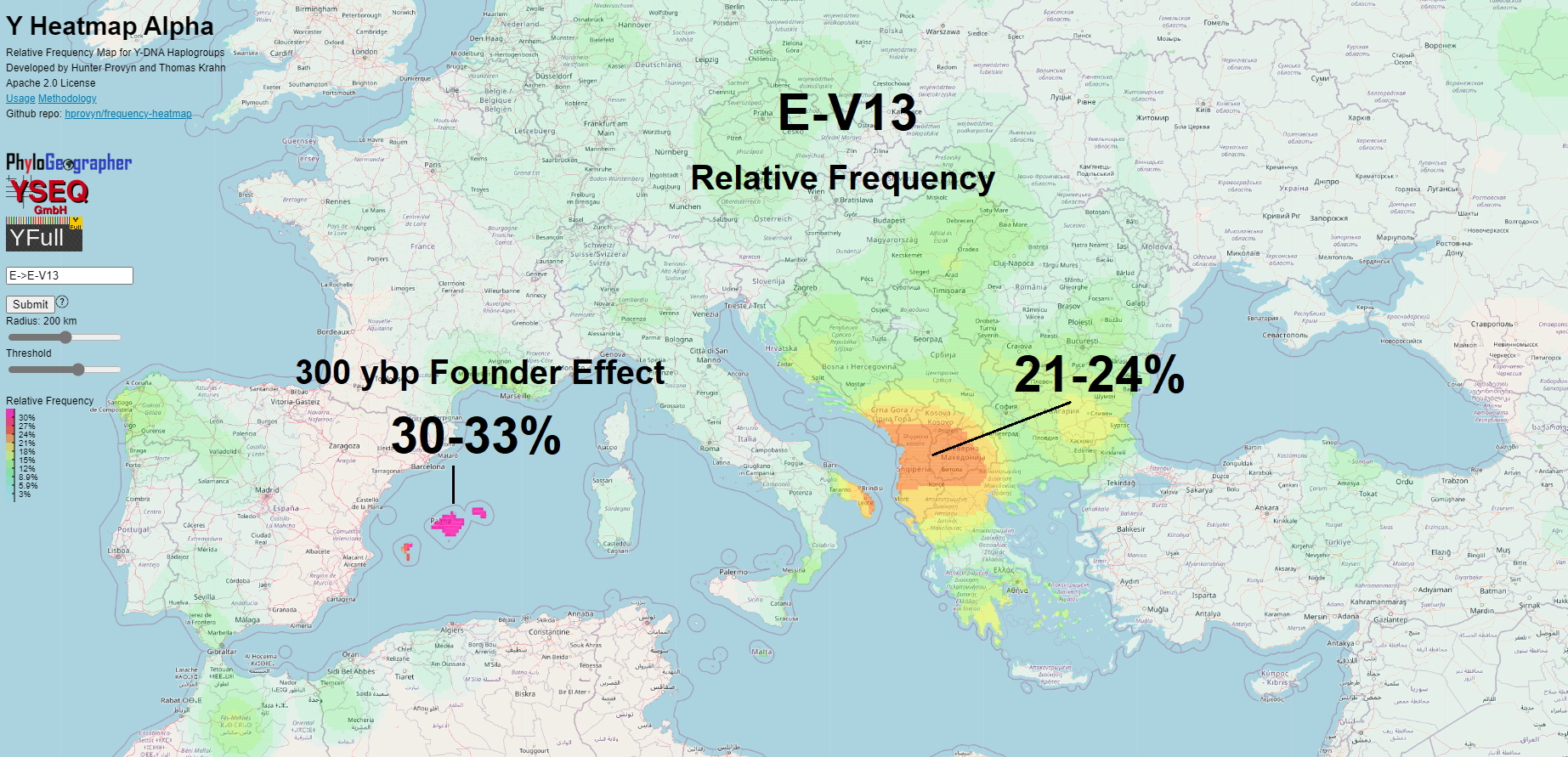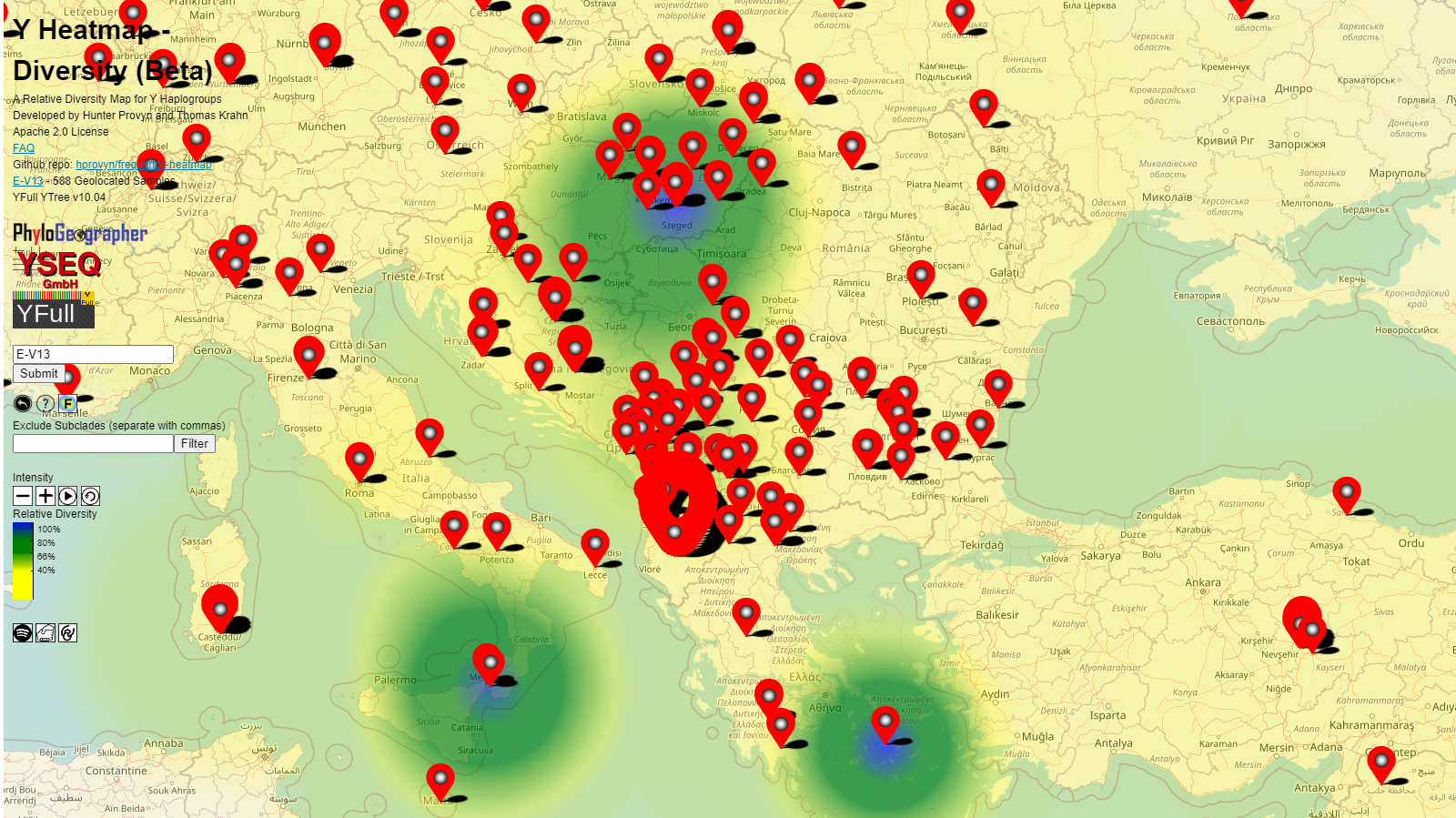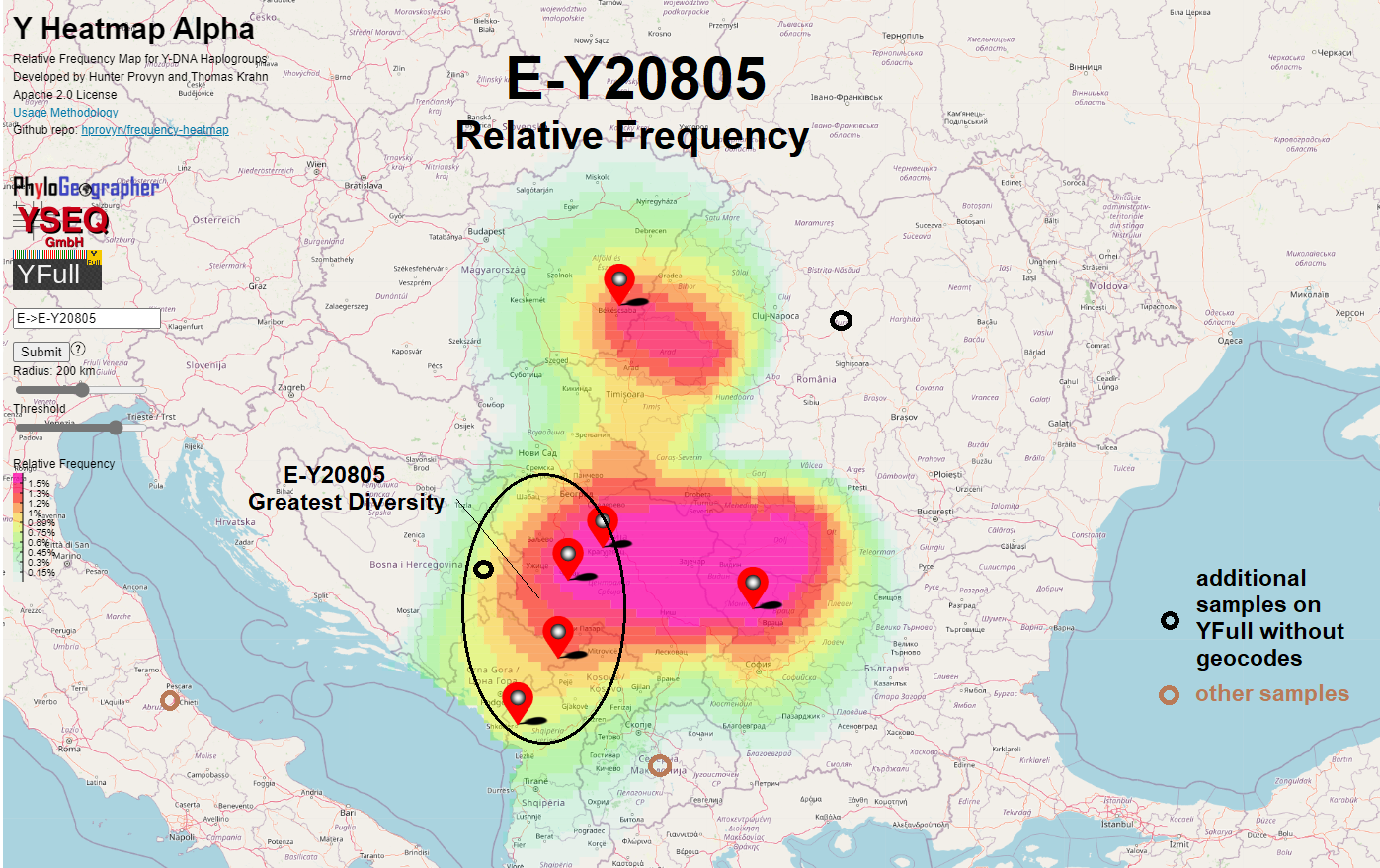I've been asked many times what I thought about E-V13, because the age and geographic distribution centered in the Balkans have some similarities with my own J2b-L283.
My answer has always been that this isn't my research focus, but that eventually I would like to delve into E-V13.
While this article focuses on an analysis of E-Y20805, I want to ground the analysis of this younger, 2800 year old lineage with what can be determined about the geography of its E-V13 ancestor. This is especially important to do because E-Y20805 has only 7 geolocated samples on the YFull tree.
E-V13 in Five Minutes from YFull YTree
It doesn't do justice to the research of prolific E-V13 to say it only takes five minutes to fully understand and evaluate its likely origins. Instead I'm providing a very high level overview of some readily quantifiable statistics that provide some initial quantitative insight.
For those wishing to go further, I encourage them take into account other data that is not necessarily limited to an analysis of geolocated samples on the YFull YTree that I present here.
The oldest ancient sample from the YFull YTree is LIB11 from 1500 ybp from Jihomoravsky kraj of Czechia.
The next nine oldest samples are all from Hungary with the oldest being about 1300 years old. They are from the Hun Avar study - "Whole genome analysis sheds light on the genetic origin of Huns, Avars and conquering Hungarians (Jan 2022)"
There is also a sample from Rome, R107, about 1250 years old.
I don't know if there are any older E-V13 ancient samples of lower resolution that could not be added to the YFull YTree. I have heard that the oldest sample is Iron Age SCY197 from Moldova and buried in a Scythian archaeological context.

The place where most E-V13 trace their male line to per capita are the Balearic Islands of Spain. This is mostly due to a founder effect where 8 / 10 of the E-V13 men who used this geocode descend from one man who lived about 300 years ago, E-Y33577.
The local maximum of E-V13 that is more likely to reflect the true origin, or a place nearer to it, is north-central Albania and the western half of North Macedonia.
E-V13 compared to J2b-L283
Just taking into account the easy to find data from the YFull YTree I created the following table comparing E-V13 to J2b-L283. We hope to glean whatever useful information we can in the absence of high resolution Bronze or Iron Age E-V13 samples on the YFull YTree as of v10.04.

* YFull only added 9 of the 17 E-V13 samples from the Hun Avar study to their tree. There were an additional 7 samples confirmed only to the level of E-L618+, some or many of which may actually be E-V13. Subsequent percentages computed as if all 17 confirmed E-V13 or 24 confirmed + probable E-V13 had been added to the YTree. I haven't analyzed these 7 samples but they must be extremely low coverage to have no reliable calls for any of the 44 SNPs currently defining E-V13 on the YFull YTree.
† There may be ancient samples of lower resolution not on the YFull YTree
‡ Five of these six samples are very closely related to each other, J-Y86930, a likely Iapydes tribe member
Two notes regarding relative frequency map:
- Three of the seven E-V13 samples with MKD geocode descend from one man who lived just 100 years ago, J-BY83158. So the high intensity around North Macedonia may not be very reliable because the low number of data points.
- The area around Kosovo for both haplogroups might not be calculated correctly by Y Heatmap as I am told that most men who trace their male line to Kosovo decline to use the YFull regional code for the area because according to the ISO standard used, it presents Kosovo as a region within Serbia.
We see that E-V13 has a higher proportion of ancient samples found in the Hun Avar study vs total samples on the YFull YTree at 1.5% compared to J2b-L283's 0.86%. However if all the confirmed and/or probable E-V13 Hun Avar samples had been added to the tree it becomes 2.9-4%. This is 3.4-4.6 times the Hun Avar rate we see with J2b-L283. This is one piece of circumstantial evidence suggesting that the E-V13 homeland might be closer to the Pannonian Basin than the J2b-L283 homeland.
The other comparisons yield additional insights.
Despite having only about 60% of the number of geolocated samples on the YFull YTree as E-V13 does, J2b-L283 has a number of high resolution samples from the Adriatic coast of Croatia and from Italy dating back to the Bronze and Iron Ages. E-V13 has none.
It is also notable that the relative maxima of each haplogroup, while geographically bordering each other, represent different regions.
J2b-L283 has relative maximum in the southern half of Albania peaking in the very southwest while E-V13's relative maximum stretches from north-central Albania to the western half of North Macedonia.
The main conclusion I draw from this comparison is that E-V13 or its early branches did not originate along the Adriatic coast of modern Croatia. More likely E-V13 originated/diversified further inland in the Balkans or Central Europe than J2b-L283, which would help explain why it did not colonize Italy to the same extent that J2b-L283 did during the Bronze and Iron Age.
I'm basing this conclusion more on the ancient samples rather than relative frequencies, which can be impacted by founder effects.
Interestingly, the diversity map computes higher diversity for E-V13 in the Pannonian Basin vs elsewhere in Central Europe or the Balkans. And this diversity calculation was based on only the limited number of 9 Hun Avar samples having been added to the YFull YTree out of the 17-20 found.

It is worth taking the Pannonian Basin into consideration as a possible origin despite the lower surviving relative frequency there. After all, the populations living in the Pannonian Basin and Danube River valley saw a lot of events in recorded history that would have led to substantial Y-DNA replacement. Notably the Mongols killed 300,000 - 500,000 people there [source].
As an example, the oldest J2b-L283 ancient sample found in Europe is from Mokrin, Serbia where we have very few J2b-L283 living today.
So until ancient samples shed further light, I would consider the region between the Pannonian Basin, North Macedonia and Central Albania to be the most likely origin of E-V13, that single man who lived about 4800 years ago.
Iron Age E-Y20805
E-Y20805 is a lineage of E-V13 descending from a Most Recent Common Ancestor who lived about 2800 years ago.

There are only seven geolocated samples on the YFull YTree from which this relative frequency map was computed. I have manually added coordinates for two samples with missing geocodes that were provided to me by Drilon Gubetini (Shkodër sample on YFull) who commissioned me to do this analysis.
The greatest diversity appears to be inside a region bounded by Rogatica (BiH), Belgrade, Kosovo, Northern Albania and Montenegro.
To advance the research the sample from North Macedonia should also do Big Y / WGS and YFull analysis.
Interestingly the paper trails of the men in this tiny branch conform closely to some patterns of E-V13:
- E-Y20805 also has an ancient sample from the Hun Avar study
- Presence in Albania and North Macedonia
Each month the relative frequency maps are updated with the latest samples on the YFull YTree.
Once more geolocated samples are added under E-Y20805 we can see how the frequency map has been recomputed by clicking here.
When there are more samples and substructure to E-Y20805, the Diversity Map tool may become useful to include in the analysis.
If you are E-Y20805 or otherwise interested to advance the research into its origins, Drilon Gubetini would be interested to hear from you - drilon gub at gmail dot com.
Thanks for reading
I'm happy to leverage my familiarity with the analytical tools I've developed to help you advance your Y-DNA research goals as a paid consultant. I also have experience solving problems with autosomal results.
I charge $50 an hour (Paypal or Zelle) and any consultation requires a $100 initial retainer.
hunter provyn at gmail dot com